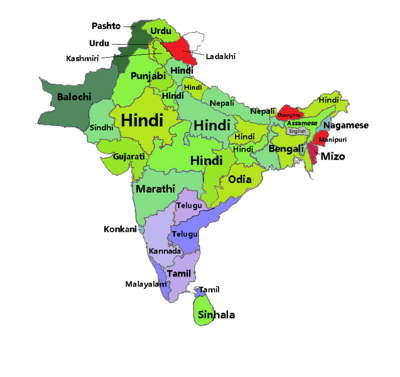Languages of South Asia
This section needs additional citations for verification. (June 2023) |


Geographical distribution
The
By country
Afghanistan
The official languages of Afghanistan are
Bangladesh
Bhutan
Almost all the languages of Bhutan are from the Tibetic family (except Nepali, an Indo-Aryan language).
India
Most languages spoken in the
Thirteen languages account for more than 1% of Indian population each, and between themselves for over 95%; all of them are the "
Scheduled languages spoken by less than 1% of Indians are
Maldives
Divehi is national language of Maldives, spoken by 95% of the population. Arabic is considered as the religious language, and English is medium of instruction for education and international purposes such as tourism.
Nepal
Most of the languages of Nepal either fall under Indo-Aryan languages or Sino-Tibetan languages. The official language of the country is Nepali, earlier known as Gorkhali in the Kingdom of Nepal, which is part of the Indo-Aryan group and is the spoken by majority of the population.
The
Pakistan
Other language families in Pakistan include
The national uniting medium of Pakistan is
etc. are also spoken.Sri Lanka
Sinhala and Tamil are the official languages of Sri Lanka, with English as the link language. Tamil is a South-Dravidian language, and Sinhala belongs to the Insular Indic family (along with Dhivehi of Maldives). Vedda is said to be the indigenous language of Sri Lanka before the arrival of the Indo-Aryans and Dravidians.
See also
- Languages of Asia
- Languages of Bangladesh
- Languages of Bhutan
- Languages of India
- Languages with official status in India
- List of languages by number of native speakers in India
- Languages of Maldives
- Languages of Nepal
- Languages of Pakistan
- Languages of Sri Lanka
References
- ISBN 978-1-316-58235-0.
- ISBN 978-3-11-081566-5.
- ISBN 978-1-4438-6761-0.
- ISBN 978-0-252-06172-1.
- ISBN 978-0-14-341639-5.
- ^ "Hindi, Hinglish: Head to Head". read.dukeupress.edu. Retrieved 29 October 2023.
- ^ Salwathura, A. N. "Evolutionary development of ‘hinglish’language within the indian sub-continent." International Journal of Research-GRANTHAALAYAH. Vol. 8. No. 11. Granthaalayah Publications and Printers, 2020. 41-48.
- ^ Vanita, Ruth (1 April 2009). "Eloquent Parrots; Mixed Language and the Examples of Hinglish and Rekhti". International Institute for Asian Studies Newsletter (50): 16–17.
- ISSN 0019-0829.
- S2CID 59247503.
- ^ a b "Bangladesh - Languages". www.britannica.com. Retrieved 10 January 2022.
- ^ Sen Nag, Oishimaya. "Which Languages Are Spoken In Bhutan?". WorldAtlas. Retrieved 12 January 2022.
- ^ "The General Conference proclaim "International Mother Language Day" to be observed on 21 February". unesdoc.unesco.org. 16 November 1999. Retrieved 21 April 2019.
- ^ a b Sen Nag, Oishimaya. "What Languages Are Spoken In Nepal?". WorldAtlas. Retrieved 19 February 2023.
- S2CID 216455412.
- ^ "A revealing map of the world's most and least ethnically diverse countries". The Washington Post. 16 May 2013. Retrieved 29 April 2022.
- ^ "The last Kirghiz khan in Gilgit | Footloose". The News International. Retrieved 29 April 2022.
- ^ "Government delivered first new Proof of Registration smartcards to Afghan refugees". UNHCR Pakistan. Retrieved 29 April 2022.
- ^ "Karachi's Gujarati speaking youth strive to revive Jinnah's language". Arab News PK. 2 October 2018. Retrieved 29 April 2022.
- ^ "Five million illegal immigrants residing in Pakistan". The Express Tribune. 16 January 2012. Retrieved 29 April 2022.
Citations
- "Indian Language Family". Central Institute of Indian Languages. Archived from the original on 15 June 2002.
- Data table of Census of India, 2001
- SCHEDULED LANGUAGES IN DESCENDING ORDER OF SPEAKERS' STRENGTH – 2001
- COMPARATIVE RANKING OF SCHEDULED LANGUAGES IN DESCENDING ORDER OF SPEAKERS' STRENGTH-1971, 1981, 1991 AND 2001
- Census data on Languages
Notes
- ^ Note that in the context of Indo-European studies, Indic languages simply refer to Indo-Aryan languages, the Indic-branch of Indo-European languages.

